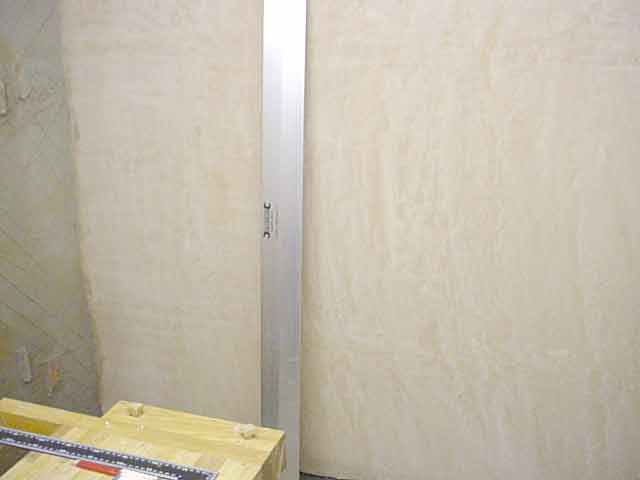
We now have our Flat surface, and we want to put a nice smooth surface onto it. This is the finishing coat.
We use Finishing plaster for this, which is a finer material that we mix up to a consistency that is something like thin chocolate sauce. We don't want this to be very thick; it isnt supposed to put lumps onto the surface. Instead it needs to flow quite smoothly onto the wall, and make about 2mm thickness - otherwise we are loosing the flatness of the plane we generated earlier.
We get the stuff on the wall, trying not to make it too thick - 2mm is the goal. Surprisingly, it doesn't have to be really flat yet - you can afford to leave trowel marks and ridges in it at this stage as long as its not too extreme. Going over it too early trying to make it flat while its still like thin chocolate sauce is futile. Instead we get the stuff on the wall quickly.
The picture below is of a wall that has been finished. It is actually quite glassy to feel, and will look smooth when painted.

At a certain point the surface begins to gell a little. Though its hard to notice directly, its like custard setting - a skim is forming. When this begins to happen, you can run a trowel over the surface and it is like ironing badly creased jeans with a steam iron - all of a sudden it just goes perfectly flat, which is quite miraculous.
Actually what you do at this stage is to put a second thin coat, again aim for 2mm, over the first. You get the ironing action with the added benefit of a second smooth layer being put down. If you are motoring along you can get away with using the same batch of plaster and just watering it down a little to keep it workable.
When the second coat gells, you can iron that down too.
Now, depending on how glassy you want a final finish (and it may be undesirable to have it too smooth), you can just run the trowel over it every 15 minutes or so as it sets harder. Each time you will be flattening marks made when the plaster was a little more fluid, and leaving some new, smaller, trowel marks in now harder plaster. At each step, you iron out what you have until you aren't making it any better any more. This process is called "polishing".
Putting a little water on the trowel will help to lubricate it as it polishes the surface, but too much water dissolves the matrix of the plaster, squeezing out what seems like a thin cream called "fat". There's nothing to be gained from that as your trowel ends up paddling in that material, which isnt setting so quickly, so you are not benefiting the surface by swimming around in it.